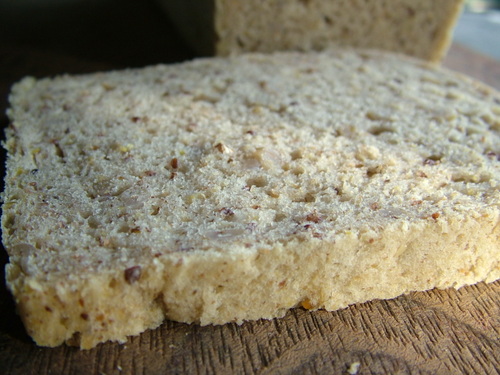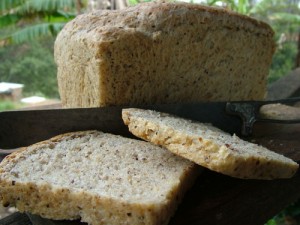I’ve cracked it – everyday bread – “everyday” meaning healthy enough for every day (even for someone too inactive to be spendthrift with carbohydrates), and “everyday” meaning easy enough to bother making even on a workday (when all I am looking forward to when I get home is a hot bath and a glass of wine).
Why bother? I’ve had a crush on sourdough for a while now, ever since Celia at Fig Jam and Lime Cordial converted me. I like a grainy, textured, hearty bread, and after a few goes I had a bread I was so addicted to I couldn’t go back to the supermarket. But I couldn’t get it to fit in around a workday.
Which is why I’m so happy. Finally I have found a low effort routine for making it work on days when I have to leave the house by 8 am and don’t get home till after 5 pm.
This is a heavy, grainy bread, nutty and chewy, and wholegrain enough to be healthy all on its own. It takes just 15 minutes to make, but that 15 minutes is spread over 24 hours. The trick is just getting into a rythum. I have been making a loaf every second or third day.
(If you don’t have sourdough starter, start asking around. Since you have to divide and feed it regularly, anyone who has some is very likely to be willing to give you some. Somewhere within six degrees of separation, there’s likely to be sourdough. Since I’ve got into it, it’s amazing how many sourdough addicts I’ve met.)
8 pm – Feed the Starter and Make a Sponge
Take the sourdough starter out of the fridge. I keep mine in a jar with the lid loosely on it, so I have to tighten the lid before shaking the jar and pouring half of it (a cupful) into a bowl.
Mix 1½ cups of water and 1½ cups of bakers flour (I use a stick blender, and Laucke Wallaby Unbleached Bakers Flour, which I can buy in 5 kg bags at the supermarket). Pour half of it back into the starter jar to top it back up. Add the other half to the starter in the bowl, along with a teaspoon of treacle.
Put the starter back in the fridge with the lid on loosely. Cover the bowl with a clean cloth and leave out on the kitchen bench.
6:30 am – Cook Some Whole Grain
I put the coffee pot on, and while waiting for it, put ¼ cup (2 handfuls) of whole wheat grains on to boil in 1½ cups of water with a good teaspoon of salt. Boil for 5 minutes, then add ¼ cup of whole millet. Boil for another 5 minutes, then add ¼ cup of steel cut oats and turn the stove off.
7:00 am – Make a Dough
The grain will have cooled and absorbed all the water, and the sourdough in the bowl will be frothy. Mix them with ½ cup bran, 1 cup rye flour, and 1 cup bakers flour. Sometimes I also add some barley flakes, pepitas, sunflower seeds or linseeds.
Flour the bench liberally and tip the mix onto it. Knead very briefly (2 or 3 minutes), adding as much flour as necessary to get a soft dough that is not too sticky.
Put a good swig of olive oil in a clean bowl and put the dough ball in it, swirling it around to coat. Cover with the clean cloth again and leave on the bench for the day.
5:30 pm – Knock Down the Dough
The dough will have easily doubled in bulk. Tip it onto the bench and knead very very briefly, just to knock it down and make it into a loaf shape. Put it in an oiled baking tin. Sprinkle the top very liberally with sesame seeds and/or poppy seeds. Slash the top with a sharp knife to give it room to rise. Cover with the clean cloth again.
7:30 pm – Bake
The bread has risen again to double its size. If I leave it too much longer, it starts to deflate again. Put it on the second shelf (that is, not right at the top) of a cold oven and turn the oven on to medium. (Sorry, I can’t be more precise – my oven is antique – but I think it is forgiving).
8:10 pm – Begin checking.
Take it out when the crust is nice and brown and it sounds hollow when knocked. Mine takes about 50 minutes from a cold oven to cooked.
I know there’s lots of fantastic sourdough bakers out there – I’d love to hear what you think. Have I missed some tricks?





I”ve never made sourdough but i’d like to give this a go. I don’t usually make bread but my father does. I do like sourdough but wonder about all the oats and stuff and such a lot of salt!
It is a heavy bread, sort of like Sol’s Megagrain if you know that. I like bread with lots of texture! Apparently there is some structural reason to put salt in bread – it affects the gluten somehow and helps the bread stay risen. I can’t bring myself to add the amount of salt in most bread recipes though – from what I’ve read, a teaspoon is little salt for bread. I have made it without salt – not deliberately, I just forgot to put it in – and it wasn’t the best bread I’ve made but it worked. It did taste bland though.
Gorgeous loaf, Linda!! It looks very healthy indeed. I’m fascinated that you put the risen dough into a cold oven – we’ve always preheated the oven to get maximum oven spring, but I guess if a dense loaf is what you’re after, you don’t need as much spring. Not that your bread looks all that heavy – there are still holes in the crumb! 🙂
Hi Celia, I’m a real amateur at this, so I’m not at all sure about the oven thing. I read somewhere about putting it in a cold oven, so I tried it and it worked. It seems to rise a decent bit more in the oven. It is a heavy bread, and part of the challenge of making it in a working day is figuring out how to get a really grainy loaf to rise and stay risen long enough to bake within the little windows of time available.
Thanks for all your great seasonal recipes and growing tips. I love this site! I thought your readers might be interested to know that it is National Permaculture Day this Sunday 1st May. There are heaps of events on all around the country – from Permablitzes to Cooking Demonstrations and film nights. You can see events in your local area at http://www.permacultureday.info/ – Thanks and keep the family friendly recipes coming. 🙂
Linda that loaf looks wonderful.
I love how versatile sourdough is. I dont think I’ve ever had a loaf turn out exactly the same. Each one seems to have its own personality, dependent on the time, bubbles, (and interuptions). You are right though, “addicts” there are a few of them out there, which I love.
(I tried the cold oven a little while ago and was surprised at how it worked as well as it did.)
Yum, we love sourdough! Does anyone know if you can make sourdough loaves from Spelt flour as my son can’t tolerate wholewheat.
Hi Kim, a friend of mine has kids who can’t eat wheat, and non-wheat breads are so expensive, she makes her own spelt sourdough every day. It’s very yum.
Thanks, Linda,
Is the recipe the same as yours just changing the flour?
kim
Rye flour has gluten too, and of course the wheat grain. And spelt is a bit heavier than wheat flour. So the process is similar, but no porridge of grains added, just spelt flour. And you may find need to find a sourdough culture that is used to spelt, or get one used to it by feeding it spelt for a little while before baking with it.
Thanks Linda, I will give it a go.
Pingback:Heavy Wholegrain Sourdough
Pingback:The Breakfast Challenge – Macadamia Sourdough Fruit Bread
Hi Linda,
Thanks you for all the great advice, receipes, garden ideas, and pictures, which are so helpful!!!! I just moved from Melbourne to Maleny and have been trying out your mandala system only about half the size. I feel like I am only just scratching the surface your design is so intricate!!!! Anyway back to bread, I couldn’t get a starter going. I think I was putting too much quantity in at a time. Finally got my hand on some now and looking forward to some good sourdough again. A friend taught me a reciepe that she learnt in france. The proportions are 10 parts flour, 6 parts water, 4 parts starter, 22 grams of salt for 1 kg flour. But it will vary slightly depending on the flour used. It is very wet so it is best to mix it in a wooden bowl ( it will rise better) everything in except the salt. Mix with french passion stretching the gluten as much as possible until you see the dough change, it will start to look smooth, then add the salt and mix a little again, the dough will change again and go even smoother and silky on the outside. Allow to rise for 4 hours until doubled. Very gently make into desired shape on put in a tin. Preheat oven to a blistering 250- 300 C
and cook for 15 – 20 mins, or until it sounds hollow when knocked. i haven’t manage this part yet as my oven never gets hot enough so it always took longer. The idea is the water turns to steam inside the loaf which creates those amazing air pockets. I hope there are some new ideas in there! Thanks again for all your posts they are inspirational.
Hi Nathaniel, I was given my starter too, and from what I’ve heard it’s harder and more hit and miss to start a new culture than it might seem. Glad you’ve got a good one now. The recipe sounds really interesting – I shall have to try it. I don’t know that my oven will get up that hot either, but we’re in the process of building a pizza oven in my community, and that should do it. Please have fun with the mandala system – Maleny is not too far north (I’m in northern NSW), but it’s far enough that all the timing will be slightly different.
looks tasty, as well as relatively fluffy (compared to what I have tried to make so far), I’m going to try this one first!
Pingback:Browsing the Supermarket Catalogue
Pingback:The Breakfast Challenge – Broad Beans on Toast
Pingback:Sourdough Made With Eggs and Yoghurt
Pingback:Planting in Early Winter
I’ve tried your sourdough recipes and love them all, especially this one! Do you put all of the barley flakes, pepitas, sunflower seeds or linseeds in or just choose one type per loaf?
Hi Maxine, I do something different every time – it depends on what I have in the pantry, what needs using, what I feel like. Too many barley flakes makes it a bit too crumbly – you can use a handful but more and you have to lighten up on the bran and other non-wheat ingredients. The pepitas and sunflower seeds I think you can go nuts with.
Hi Linda
Your recipes seem to be the old fashioned ones (in nice hearty way). I am going to try them for sure.
Just wondering, though, why you specify putting the loaf into a cold oven. Is there a reason for that? Most of the recipes I read specify a hot oven, starting at about 330 degressC and then reducing by about 20 – 30 degressC after 10 minutes or so.
Also, do you bake the loaf with steam in the oven?
Thanks
Joy
Sorry I meant 230 degrees, not 330!
Hi Joy, I think with my heavy megagrain sourdough, l’m looking for a thin light crust. For ciabatta or vienna style bread, a nice crisp crust works better and a hot oven and steam gives it. For my heavy breads, I think the extra time for the middle to cook without burning the crust comes from a cold oven. But hey, my mentor for dourdough is Celia at Fig Jam and Lime Cordial. She’s much more of and expert than me.